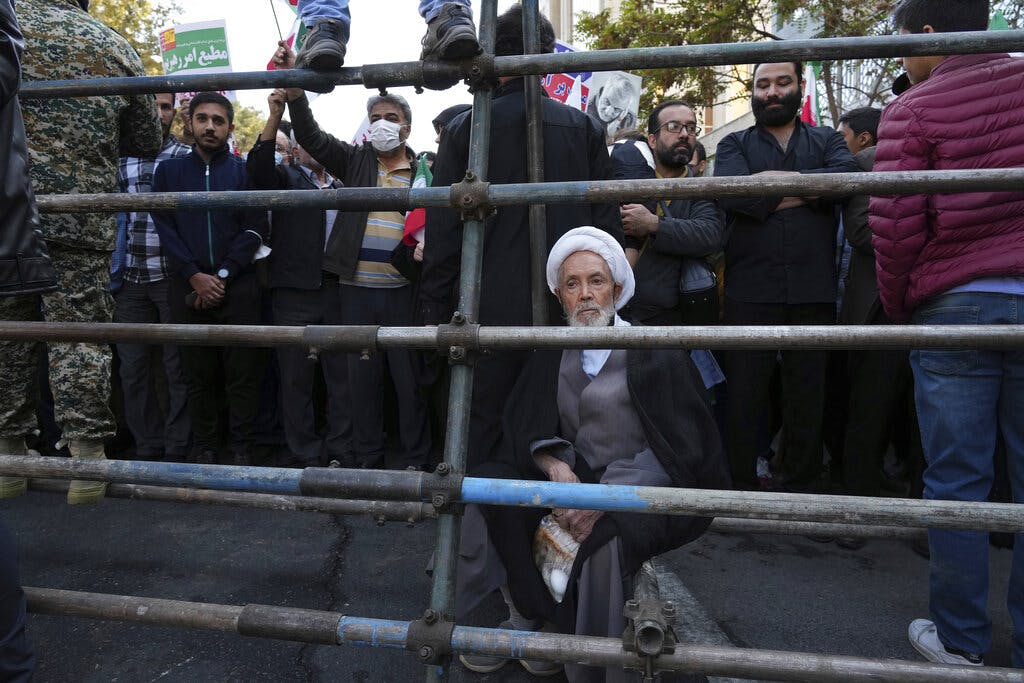In Iran, Knock-a-Turban Protest Gains Steam as Part of Anti-Hijab Movement
Apologists for the regime claim islamophobia and elder abuse, but such critiques overlook the centrality of garb and the symbolism dress codes carry in Iranian discourse.

As the anti-hijab movement gains popularity on Iranian streets, young adherents who are seeking an end to the Islamic Republic regime are taking it to another level with a new fad: knock-a-turban.
Young men and women, who are the vanguard of the current anti-Ayatollah revolution, film themselves walking behind older men clad in traditional Shiite garb and then gently knocking the turbans off the men’s heads. While the men stoop to pick up the headdress, onlookers laugh and make jeering sounds.
Regime supporters are seizing on the meme-inducing phenomenon, claiming that the anti-hijab movement is islamophobic to the core. Some even call it elder abuse. Yet, such critiques overlook the centrality of garb and the symbolism dress codes carry in Iranian discourse.
The current protest has gained steam since the September 16 death of 22-year-old Mahsa Amini, a Kurdish-Iranian visitor to Tehran who died in jail. She was arrested by the so-called morality police for failing to wear the mandatory headdress in full accordance with the authorities’ guidelines.
The #MahsaAmini hashtag has been the most unifying slogan of the current revolt. Women of all ages defiantly remove their hijabs in public, and at times cut their hair, as an expression of solidarity with Amini and others who have died as the protest widened. Men have joined the protest as well, in many cases defying bullets shot by police, aggressive Basij volunteer militiamen, and the Revolutionary Guards.
As the knock-a-turban protests gain popularity on the streets and on social networks, regime supporters say that just like removing the hijab, it shows disrespect to religious men.
That form of protest is an “assault on the citizens who wear clerical clothes and walk the streets,” an Iranian describing himself as “activist, politician, journalist,” Saeed Shariati, tweeted. Further, he argued, some of the assaulted turban-wearers may even support the protesters’ cause.
“No cleric is supportive of anti-compulsory hijab protest,” an Iranian-American journalist and activist who protested hijab rules years before it became a national phenomenon, Masih Alinejad, countered. A supporter of the knock-a-turban phenomenon, Ms Alinejad has amplified it on her widely followed social media accounts.
“The turban protest started as a grassroots movement inside Iran,” Ms. Alinejad told the Sun, in response to a question about how it may discredit the largely nonviolent anti-regime movement. “The real violence is done by the security forces who are using guns and bullets to kill more than 200 protesters,” she said. In contrast, when turbans are being knocked “at worst, the ego of some cleric gets hurt, nothing more.”
Yet, critics insist that removing a religious symbol, such as the turban, is a bigoted phenomenon, akin to street assaults against Orthodox Jews in places like Brooklyn.
“It’s nothing like those antisemitic attacks,” a Jerusalem-based Farsi-language broadcaster, Menashe Amir, said. The turban protesters do not randomly target citizens for their religious symbols, he told the Sun. “It has nothing to do with hatred of a religion. It is a form of protest against an oppressive regime.”
The Iranian clerics have long used dress codes as part of the Islamic Republic’s coercion of the citizenry. Since 2000, graduates of Iranian clerical seminars have been receiving their turbans in ceremonies meant to convey the regime’s authority and to unite its enforcers, an Iran watcher at Tel Aviv university, Raz Zimmt, writes.
Turban-knocking, Mr. Zimmt notes, precedes the current fad by many decades: While in exile at the Iraqi holy city of Najaf in 1970, the Islamic Revolution’s founder, Ayatollah Khomeini, urged his adherences to forcefully remove turbans from the heads of Shah-supporting clerics, whom he considered heretics unworthy of donning the religious symbol.
Beyond the turban, the Islamic Republic has eschewed neckties, which it considers a symbol of Western hegemony and a tool of America, the “Great Satan.” Tehran officials decline to wear ties in international forums, where they are common or even required.
Yet, none of the Islamo-revolutionary dress codes have been as strongly enforced as the decree forcing women to cover their hair. For years, Ms. Alinejad and others have taken Western women to task for conforming with the regime’s hair-covering rules while visiting Iran as officials or journalists.
One journalist who has long felt the need to wear a hijab even while speaking with Iranian officials at New York or London, CNN’s Christiane Amanpour, recently missed an interview with President Raisi. After Ms. Amanpour went against “protocol” by this time refusing to cover her hair, Mr. Raisi canceled the interview, according toTehran media reports.
The new protest, then, is far from an elder-abusing form of violence directed at pious men who want to peacefully practice their religion. In a country where dress indicates your status — either as a member of a powerful, oppressive elite or an abused, second-class female — knocking a turban off is a form of turning the table on the authorities.

